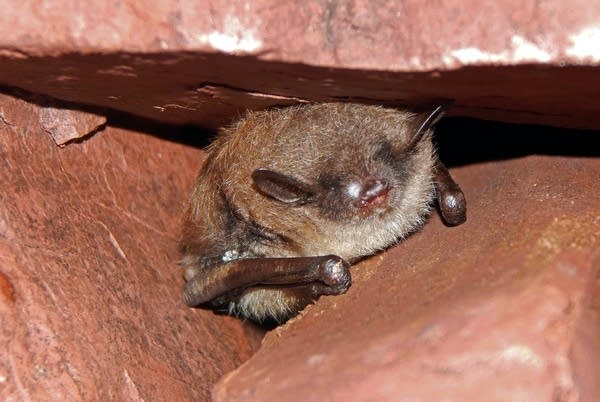Disease that kills bats confirmed at Minnesota state park

Go Deeper.
Create an account or log in to save stories.
Like this?
Thanks for liking this story! We have added it to a list of your favorite stories.
Updated: 4:30 p.m. | Posted: 9:27 a.m.
Minnesota officials have confirmed the state's first outbreak of white nose syndrome in bats. The disease can wipe out entire colonies.
The Department of Natural Resources said several hundred bats have been found dead near the mine entrance at Lake Vermilion-Soudan Underground Mine State Park since late January. Tests confirm the bats were infected with white nose syndrome.
Turn Up Your Support
MPR News helps you turn down the noise and build shared understanding. Turn up your support for this public resource and keep trusted journalism accessible to all.
Bats began flying out of the Soudan Mine in January and dying of exposure. The mine contains the largest population of hibernating bats in Minnesota.
The disease is named for the fuzzy white growth of fungus observed on infected bats. The fungus was detected in 2013 at both Soudan Underground Mine and Forestville/Mystery Cave state parks in Minnesota. The DNR said it's typical for the disease to appear two to three years after the fungus.
The disease has spread to 27 states and five provinces since 2007.

Jeremy Coleman, national coordinator for white nose syndrome in the U.S. Fish and Wildlife Service, said Minnesota's case is comparable to outbreaks in Ontario, Michigan and Wisconsin.
"I think you can expect basically the same response there, which is 90-percent-plus mortality," he said. "But there are differences that we've seen in locations, and there's also differences in the rate of decline we've seen in locations."
Officials say a decline in bat populations could lead to higher mosquito numbers.
Research posted on the DNR website suggests the pest control bats provide for Minnesota corn and soybeans is worth more than $1 billion a year.
Coleman said there is no treatment for white nose syndrome, although there are several promising research studies. One study is trying to isolate naturally occurring antifungal materials from the Soudan mine.
Coleman says it's a hard disease to treat, similar to athletes food or toenail fungus in humans.
"Not just to be able to treat the fungus but also to not impact the surrounding environment," he said. "So one of the key pieces to this is finding anti-fungal compounds, biologically derived anti-fungal compounds within a local area."



